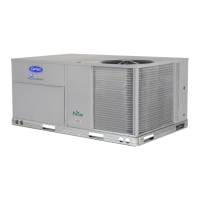22
Fig. 32 — Handle and Shaft Assembly for HACR
Circuit Breaker
UNITS WITHOUT FACTORY-INSTALLED NON-FUSED
DISCONNECT OR HACR CIRCUIT BREAKER
When installing units, provide a disconnect switch per NEC
(National Electrical Code) of adequate size. Disconnect sizing
data is provided on the unit informative plate. Locate on unit
cabinet or within sight of the unit per national or local codes.
Do not cover unit informative plate if mounting the disconnect
on the unit cabinet.
ALL UNITS
All field wiring must comply with NEC and all local codes.
Size wire based on MCA (Minimum Circuit Amps) on the unit
informative plate. See Fig. 27 and unit label diagram for power
wiring connections to the unit and equipment ground. Maxi-
mum wire size is #4 ga AWG (copper only) per pole on contac-
tors and #2ga AWG (copper only) per pole on optional non-
fused disconnect or HACR.
Provide a ground-fault and short-circuit over-current protection
device (fuse or breaker) per NEC Article 440 (or local codes).
Refer to unit informative data plate for MOCP (Maximum
Over-current Protection) device size.
NOTE: Units ordered with factory-installed HACR do not need an
additional ground-fault and short-circuit over-current protective
device unless required by local codes.
All field wiring must comply with the NEC and local require-
ments.
All units except 208/230-v units are factory wired for the volt-
age shown on the nameplate. If the 208/230-v unit is to be con-
nected to a 208-v power supply, the control transformer must
be rewired by moving the black wire with the
1
/
4
-in. female
spade connector from the 230-v connection and moving it to
the 208-v
1
/
4
-in. male terminal on the primary side of the trans-
former. Refer to unit label diagram for additional information.
Voltage to compressor terminals during operation must be
within voltage range indicated on unit nameplate. On 3-phase
units, voltages between phases must be balanced within 2%
and the current within 10%. Use the formula shown below to
determine the percent of voltage imbalance. Operation on im-
proper line voltage or excessive phase imbalance constitutes
abuse and may cause damage to electrical components. Such
operation would invalidate any applicable Carrier warranty.
Unbalanced 3-Phase Supply Voltage
Example: Supply voltage is 230-3-60
AB = 224 v
BC = 231 v
AC = 226 v
Determine maximum deviation from average voltage.
(AB) 227-224 = 3 v
(BC) 231-227 = 4 v
(AC) 227-226 = 1 v
Maximum deviation is 4 v.
Determine percent of voltage imbalance.
This amount of phase imbalance is satisfactory as it is below
the maximum allowable 2%.
NOTE: Check all factory and field electrical connections for
tightness.
CONVENIENCE OUTLETS
Two types of convenience outlets are offered on 48HC models:
non-powered and unit-powered. Both types provide a 125-volt
GFCI (ground-fault circuit-interrupter) duplex receptacle rated
at 15-A behind a hinged waterproof access cover, located on
the end panel of the unit. See Fig. 33.
IMPORTANT: Never operate a motor where a phase
imbalance in supply voltage is greater than 2%. Use
the following formula to determine the percentage of
voltage imbalance.
% Voltage Imbalance = 100 x
max voltage deviation from
average voltage
average voltage
Average Voltage =
(224 + 231 + 226)
=
681
=227
33
% Voltage Imbalance = 100 x
4
=1.78%
227
IMPORTANT: If the supply voltage phase imbalance
is more than 2%, contact your local electric utility
company immediately.
WARNING
ELECTRICAL OPERATION HAZARD
Failure to follow this warning could result in personal
injury or death.
Units with convenience outlet circuits may use multiple
disconnects. Check convenience outlet for power status
before opening unit for service. Locate its disconnect
switch, if appropriate, and open it. Lock-out and tag-out
this switch, if necessary.
A
B
C
MOTOR

